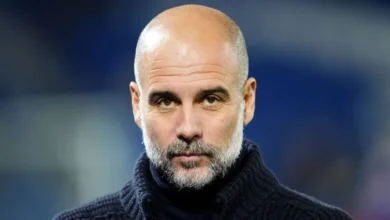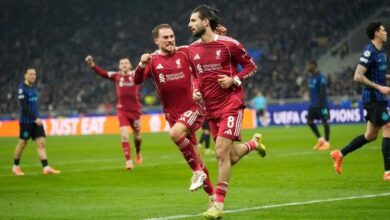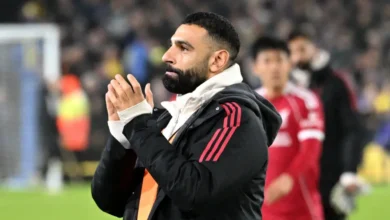Real Madrid prepared to wait for Man City star Rodri as Spanish giants hope to snap up midfielder

Real Madrid’s transfer philosophy has always been characterized by patience, precision, and an unwavering commitment to securing world-class talent. However, the recent developments surrounding their pursuit of midfield reinforcements have highlighted both the challenges of modern football’s transfer market and the club’s adaptive strategic thinking. With Arsenal appearing to have secured the services of Real Sociedad’s Martin Zubimendi, Los Blancos have reportedly shifted their focus to an even more ambitious target: Manchester City’s Ballon d’Or winner Rodri.
The Spanish giants’ interest in the City midfielder represents more than just a response to missing out on their primary target. It signifies a fundamental shift in approach, moving from immediate solutions to long-term strategic acquisitions that could define the club’s midfield for the next decade. This development has sent ripples through European football, with observers noting that Real Madrid’s willingness to wait until 2026 demonstrates both their financial prudence and their confidence in their current squad’s capabilities.
The Zubimendi Disappointment: A Catalyst for Greater Ambitions
Martin Zubimendi’s near-certain move to Arsenal represents a significant blow to Real Madrid’s immediate transfer plans. The Real Sociedad midfielder had been identified as the perfect profile to complement the club’s existing midfield triumvirate of Eduardo Camavinga, Aurélien Tchouaméni, and Federico Valverde. His technical ability, defensive acumen, and deep understanding of Spanish football made him an ideal candidate to slot seamlessly into Carlo Ancelotti’s tactical framework.
However, Arsenal’s decisive action in triggering Zubimendi’s €60 million release clause, combined with their willingness to offer a substantially higher salary package, has effectively ended Madrid’s pursuit of the 25-year-old. The Gunners’ confidence in completing the deal reflects not only their financial muscle but also their clear identification of Zubimendi as a missing piece in their championship puzzle.
For Real Madrid, this setback represents more than just a missed opportunity. It highlights the increasingly competitive nature of the modern transfer market, where clubs must be prepared to act swiftly and decisively. The failure to secure Zubimendi has forced the Spanish giants to reassess their approach, leading to the emergence of an even more audacious plan centered around Manchester City’s pivotal midfielder.
Rodri: The Ultimate Prize in European Football
The consideration of Rodrigo Hernández Cascante, known simply as Rodri, as a potential target represents Real Madrid’s ambition at its most grandiose. The 28-year-old Spanish international has established himself as arguably the finest defensive midfielder in world football, a status that was officially recognized when he claimed the 2024 Ballon d’Or award. His transformation from a promising Atlético Madrid academy graduate to the heartbeat of Pep Guardiola’s Manchester City machine represents one of modern football’s greatest success stories.
Rodri’s importance to Manchester City cannot be overstated. Since joining the club from Atlético Madrid in 2019 for €70 million, he has become the fulcrum around which Guardiola’s tactical philosophy revolves. His ability to dictate tempo, break up opposition attacks, and initiate City’s intricate passing sequences has made him indispensable to their success. The statistics bear testament to his influence: City’s win percentage drops significantly when he is absent from the lineup, a fact that was starkly illustrated during his injury-enforced absence earlier in the season.
The Spanish midfielder’s playing style perfectly embodies the modern interpretation of the defensive midfielder role. Unlike the purely destructive players of previous generations, Rodri combines exceptional defensive awareness with remarkable technical ability and tactical intelligence. His positioning is almost supernatural, allowing him to intercept passes and break up attacks before they fully develop. Simultaneously, his range of passing and ability to carry the ball forward make him equally effective in the attacking phase of play.
The 2026 Timeline: Strategic Patience Meets Financial Pragmatism
Real Madrid’s reported willingness to wait until 2026 to pursue Rodri demonstrates a level of strategic thinking that has become increasingly rare in modern football’s instant-gratification culture. By targeting the final year of his Manchester City contract, Los Blancos are positioning themselves to secure one of football’s premier talents at a significantly reduced cost. This approach reflects both financial pragmatism and confidence in their current squad’s ability to compete at the highest level in the interim.
The timing of this potential move is particularly significant when viewed through the lens of Real Madrid’s squad planning. By 2026, several key players will be entering different phases of their careers. Luka Modrić, assuming he continues playing, will be 40 years old, while Toni Kroos has already announced his retirement from professional football. This natural transition period creates the perfect opportunity to integrate a player of Rodri’s caliber into the squad structure.
Furthermore, the 2026 timeline allows Real Madrid to observe how their current midfield develops over the next two seasons. Camavinga, Tchouaméni, and Valverde are all still young players with significant room for growth. The club’s willingness to wait suggests confidence that these players can continue to develop and maintain Real Madrid’s competitive edge in the short term while preparing for the long-term integration of a generational talent like Rodri.
Manchester City’s Dilemma: Keeping the Cornerstone
From Manchester City’s perspective, losing Rodri would represent a catastrophic blow to their ambitions. The Spanish midfielder has become so integral to their playing style that replacing him would require not just finding a player of similar quality but potentially restructuring their entire tactical approach. Pep Guardiola has often spoken about Rodri’s unique attributes and his irreplaceable role within the team structure.
However, City also faces the harsh reality of contract negotiations in modern football. Players of Rodri’s caliber command enormous salaries, and the competition for their services is fierce. If Real Madrid were to make a concrete offer in 2026, they would likely be able to offer not just financial incentives but also the prestige and history that comes with representing one of football’s most successful clubs.
The Premier League champions will undoubtedly attempt to secure Rodri’s future before he enters the final year of his contract. A renewal would not only guarantee his services but also protect City’s investment in one of their most valuable assets. However, the allure of Real Madrid, particularly for a Spanish player, cannot be underestimated. The opportunity to return to La Liga and represent the most successful club in Champions League history would present a compelling proposition for any player.
The Current Midfield Conundrum: Balancing Present and Future
Real Madrid’s current midfield situation presents both opportunities and challenges. The presence of Camavinga, Tchouaméni, and Valverde provides a solid foundation for the present while offering significant potential for the future. However, questions remain about whether this trio possesses the tactical sophistication and game management skills necessary to control matches at the highest level consistently.
Camavinga, at 22, has shown flashes of brilliance but remains inconsistent in his performances. His energy and athleticism are undeniable assets, but his positional discipline and decision-making in crucial moments continue to develop. The French midfielder’s versatility allows him to play multiple positions, but this flexibility sometimes comes at the expense of specialization in any particular role.
Tchouaméni, the most expensive of the three at €80 million from AS Monaco, arrived with enormous expectations but has struggled to establish himself as the dominant presence many anticipated. His physical attributes and technical ability are evident, but adapting to Real Madrid’s playing style and the pressure of representing the club has proven challenging. The French international’s development trajectory will be crucial to the club’s midfield plans over the next two seasons.
Valverde represents perhaps the most consistent performer among the trio, offering reliability and work rate that Ancelotti clearly values. The Uruguayan’s box-to-box capabilities and willingness to sacrifice for the team make him an invaluable squad member. However, questions persist about whether he possesses the creative spark and tactical awareness to be the controlling influence in Madrid’s midfield.
The Broader Context: Real Madrid’s Transfer Philosophy
The pursuit of Rodri, even on a delayed timeline, reflects Real Madrid’s enduring commitment to the ‘Galáctico’ philosophy while adapting it to modern football’s financial realities. Rather than pursuing immediate, expensive solutions, the club appears willing to combine patience with strategic planning to secure transformational talents at optimal prices.
This approach represents an evolution of the club’s transfer strategy, moving away from the reactive, headline-grabbing signings of previous eras toward a more calculated, long-term vision. The willingness to wait for Rodri while developing current players demonstrates a maturation in the club’s approach to squad building that acknowledges both financial constraints and the importance of sustainable success.
The strategy also reflects Real Madrid’s confidence in their ability to remain competitive while planning for the future. The club’s recent Champions League success and domestic achievements provide evidence that their current approach is yielding results, even if individual transfer targets sometimes slip away.
Tactical Implications: How Rodri Would Transform Madrid’s Play
The potential addition of Rodri to Real Madrid’s squad would have profound tactical implications for how the team approaches matches. His presence would provide the defensive security and tempo control that would allow the club’s attacking talents greater freedom to express themselves. The Spanish midfielder’s ability to shield the defense while simultaneously initiating attacks would create a more balanced and sustainable playing style.
Rodri’s positional intelligence would also address one of Real Madrid’s recurring issues: maintaining control in the middle of the park during high-pressure situations. His experience in big matches and ability to remain composed under pressure would provide the kind of leadership and stability that championship-winning teams require.
Furthermore, his integration would allow for greater tactical flexibility within the squad. Players like Camavinga and Valverde could be deployed in more attacking roles, utilizing their energy and pace in areas where they can have maximum impact. This tactical evolution would make Real Madrid less predictable and more difficult to defend against.
The Financial Landscape: Making the Numbers Work
Real Madrid’s interest in Rodri must be viewed within the context of modern football’s financial landscape. The potential to secure a player of his caliber in the final year of his contract represents significant value in a market where similar talents command transfer fees exceeding €100 million. This approach allows the club to allocate resources more efficiently while still acquiring world-class talent.
The financial benefits extend beyond the initial transfer fee. By waiting until 2026, Real Madrid can better plan their wage structure and ensure that Rodri’s arrival doesn’t disrupt the squad’s financial equilibrium. This patient approach also allows the club to assess their other priorities and make informed decisions about squad composition.
However, the strategy is not without risks. Other clubs may identify similar opportunities and compete for Rodri’s signature, potentially driving up costs or complicating negotiations. Additionally, there’s no guarantee that the player will be available or interested in a move when the time comes.
Competition and Market Dynamics
Real Madrid’s interest in Rodri will not exist in a vacuum. Other elite clubs will undoubtedly monitor his situation, particularly if he enters the final year of his contract without renewal. Barcelona, despite their financial constraints, would likely view him as an ideal addition to their midfield. Premier League clubs with substantial resources might also enter the conversation, offering the advantages of familiar surroundings and potentially superior financial packages.
The competition for Rodri’s signature would likely be intense, requiring Real Madrid to leverage their unique selling points: history, prestige, and the opportunity to compete for the Champions League annually. For a Spanish player, the appeal of representing Real Madrid carries particular weight, but this emotional connection must be balanced against practical considerations like wages, playing time, and tactical fit.
Long-term Vision: Building for the Next Decade
The potential pursuit of Rodri represents more than just a single transfer; it embodies Real Madrid’s vision for the next decade. By 2026, the club will likely be in a transition period, with several legendary players having retired or moved on. The integration of a player like Rodri would provide continuity and leadership during this transitional phase.
This long-term thinking extends to the development of younger players within the system. The presence of an elite midfielder like Rodri would provide a model for emerging talents and raise the overall standard within the squad. His experience and professionalism could prove invaluable in mentoring the next generation of Real Madrid midfielders.
Conclusion: A Calculated Gamble on Future Success
Real Madrid’s reported interest in Manchester City’s Rodri represents a fascinating intersection of ambition, pragmatism, and strategic patience. While the disappointment of missing out on Martin Zubimendi provided the initial catalyst, the emergence of Rodri as a target demonstrates the club’s unwavering commitment to securing world-class talent.
The 2026 timeline presents both opportunities and challenges. It allows Real Madrid to pursue one of football’s premier players at a potentially reduced cost while providing time for current squad members to develop. However, it also requires faith that the current group can maintain the club’s competitive standards and that Rodri will be available and interested when the time comes.
This approach reflects a more mature and calculated version of Real Madrid’s transfer philosophy. Rather than pursuing immediate solutions at premium prices, the club appears willing to combine patience with strategic planning to secure transformational talents. Whether this strategy ultimately succeeds will depend on numerous factors, including Manchester City’s ability to retain their star midfielder and the development of Real Madrid’s current players.
What remains clear is that Real Madrid’s interest in Rodri, even on a delayed timeline, demonstrates their enduring ambition to assemble the world’s finest talents. The potential addition of the Ballon d’Or winner would not only strengthen their midfield but also send a powerful message about their intentions for the future. In an era where patience is increasingly rare in football, Real Madrid’s willingness to wait for the right player at the right price may ultimately prove to be their greatest strength.
The coming months will provide greater clarity on whether this strategic approach yields the desired results. For now, the football world watches with interest as one of the game’s most successful clubs plots its next move in the eternal pursuit of excellence. Whether Rodri ultimately joins Real Madrid remains to be seen, but the very possibility of such a transfer highlights the dynamic and ever-changing nature of modern football’s transfer market.















